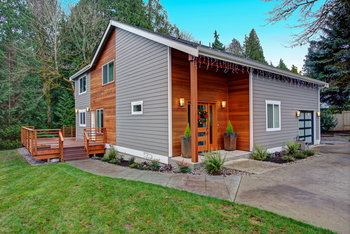
Homeowners have several options when it comes to a mortgage refinance. They can do:
A "cash-in" refinance: Borrowers bring cash to the settlement in order to reduce the size of their existing home mortgage principal. Cash-in refinances can be used to eliminate private mortgage insurance, or to help produce even lower monthly payments than a lower interest rate alone will provide.
A "cash-out" refinance: In a cash-out refinance, a homeowner takes some of the equity out of their home and gets a new loan with a larger principal balance. Cash-out refinances are common for homeowners looking to do home improvement or renovation projects, consolidate higher rate debts and other reasons, such as paying off any outstanding second mortgage or HELOC.
A "rate-and-term" refinance: Borrowers get a new loan to change the interest rate and term of their mortgage while maintaining the original remaining principal amount. Instead of increasing or decreasing the mortgage balance, this option leaves the loan amount unchanged. The most common reason to refinance, rate-and-term refinancing usually provides lower monthly payments and improved cash flow, but could come at the expense of higher total interest costs over time.
Rate and term refinance
Homeowners have different reasons for refinancing and each can indicate that one refinance option or another makes the most sense. Before choosing a new home loan, think about your refinancing goals and consider these rate and term refinance guidelines.
If you want to pay off your loan faster, see if you can afford the payments on a shorter-term loan.
Shorter-term mortgages also have an advantage over longer-term loans. They are usually offered at lower interest rates. For example, 15-year mortgages are typically available at interest rates of a half-percentage point (or more) below those of 30-year fixed-rate mortgages. Depending on the interest rate and how short of a loan term you choose, a shorter loan term may bring you with higher monthly payments, which could make it more difficult for you to qualify.
If you are focused on reducing your monthly mortgage payment, a lower rate or a longer mortgage term might be a better choice, so check out today's mortgage rates and use a mortgage refinancing calculator to estimate your savings.
Unlike many other simple "break-even" refinance calculators that only seek to tell you when you've recaptured any closing cost outlays for your refinance, HSH's "Should I refinance my mortgage?" calculator also factors total interest costs over time, giving you an accurate time frame for when refinance savings actually begin. You might not expect it, but it's even possible to refinance at a higher interest rate when you refinance and still come out ahead over a given period of time.
A rate-and-term refinance works best for borrowers who want to take advantage of lower interest rates to lower their monthly payments or to reduce the overall amount of interest they pay on their mortgage. This type of refinance is also valuable for homeowners who want to completely pay off their mortgage before a certain date, such as retirement or when their children go to college.
If you really would prefer not to re-extend the term of your loan to another 30 years, you might consider refinancing and then prepaying your loan. Via mortgage prepayments, you can make a fixed-rate mortgage virtually any term you wish. HSH's It's My Term prepayment calculator can do the mortgage-payment math for you.
Depending on your time frame and refinance rates available in the market, it's also possible and potentially valuable to refinance out of a fixed-rate mortgage and into an adjustable-rate mortgage. The most popular ARM has a fixed interest rate for the first five years and is often available at rates as much as a full percentage point below those found on 30-year fixed-rate mortgages. If your expected time horizon is short -- for example, you plan on selling your home and downsizing within five years -- refinancing into an adjustable-rate mortgage may be a way to capture even more savings from your refinance.
Qualifying for a Rate-and-Term Refinance
It may be easier for you to qualify for a rate-and-term refinance than when you got your current mortgage. To start with, you'll have already paid down some of the original loan balance of your existing loan, so you'll be borrowing a new mortgage with a smaller loan amount.
In addition, there's a good chance that your home's value has increased a bit since you took your original mortgage. Coupled with the paydown of principal, this means you'll have a slightly larger home equity stake -- or in lender terms, a lower loan-to-value (LTV) ratio. A lower LTV ratio may allow you access to lower mortgage rates, and if your home has appreciated strongly or you've been there for a while, you may have enough equity to cancel private mortgage insurance, something that would also save you some money each month. Even if your new mortgage requires private mortgage insurance, a decline in your LTV ratio can mean you're eligible for a lower-cost PMI premium.
Having an existing mortgage that you've paid on time may have boosted your credit score. Your credit score not only takes into account how long you've had credit and how well you've managed it, but the mix of credit you hold also plays a role.
There's also the likelihood that your income has risen since you've owned your home. If you haven't taken on a lot of new debt, a higher income would mean a lower Debt-to-Income ratio (DTI), and a lower DTI can both make it easier to qualify and may bring lower rates, too.
Is refinancing mortgage a good idea?
Mortgage rates have been low for quite some time now, so it may be difficult for some borrowers to find a refinance rate that is significantly lower than that on their existing loan. Remember to calculate closing costs when evaluating your refinance; borrowers have several options for paying closing costs, such as wrapping them into the loan's principal balance, paying them in cash or paying a higher interest rate to cover the costs. HSH's Tri-Refi Calculator can help you see how various options work out for you.
If you're in an FHA-backed mortgage and are looking to do a simple rate and term refinance, you may be able to take advantage of FHA's streamline refinance arrangement, where a lender offers you new loan and lower monthly payment with reduced paperwork and lower cost. Conversely, if you're in an FHA loan but have an equity stake in excess of 20%, you could refinance out of your current loan where MI cannot be canceled into a new conventional loan that doesn't require it.
Shopping for your Rate-and Term Refinance
When shopping for your rate-and-term refinance, one place to consider is your existing lender. Some lenders offers reduced-cost or "streamlined" refinances to existing customers, which may offer you a level of convenience. Be aware, though, that convenience may cost you -- your existing lender may or may not be offering especially competitive rates, even if they can offer you a faster or simpler process.
So, while your existing lender should be one of the places you shop, it should not be the only place. You'll want to check with a range of mortgage lenders offering deals, as it can pay to aggressively shop for a new loan. Mortgage rates can vary from lender to lender by a fair amount, and it's not uncommon to see a quarter percentage point difference (or more) from lender to lender for the same mortgage type and specifications. If you like, you can use this handy mortgage shopping worksheet (PDF) as you talk to mortgage refinance lenders.
If you're concerned about the effect shopping for a refinance may have on your credit score, don't worry. The credit reporting bureaus expect you to shop for your mortgage refinance, and even multiple credit reviews by mortgage lenders will be treated as one credit "pull" if they occur within a few-week timeframe.
It's also worth keeping in mind that shopping hard for your refinance is to your benefit. Unlike getting the mortgage to purchase your home, you have the benefit of more time to shop on your side.



